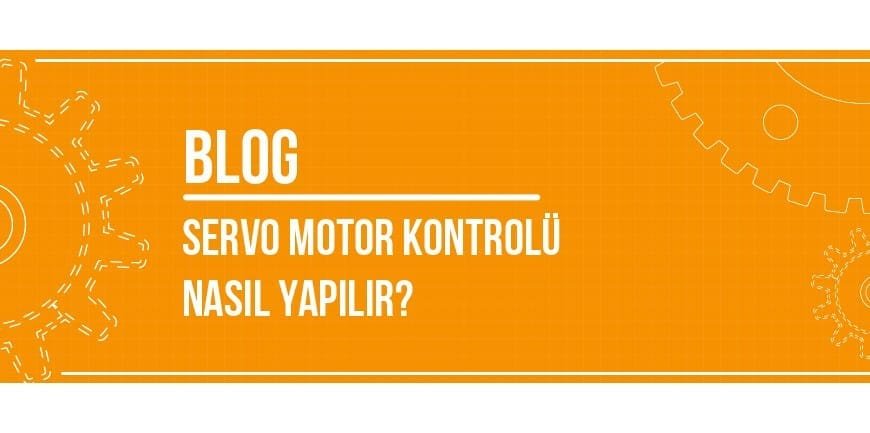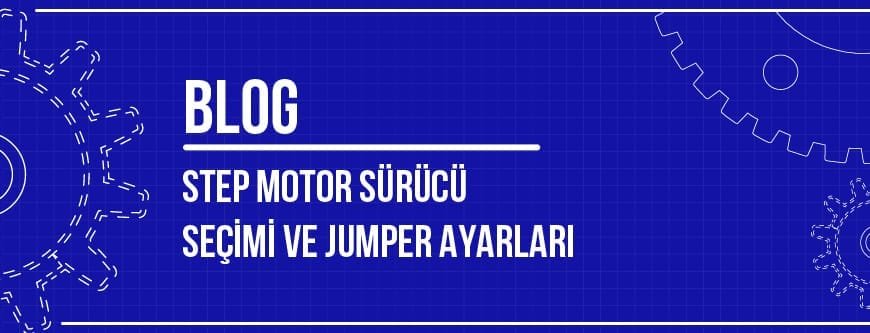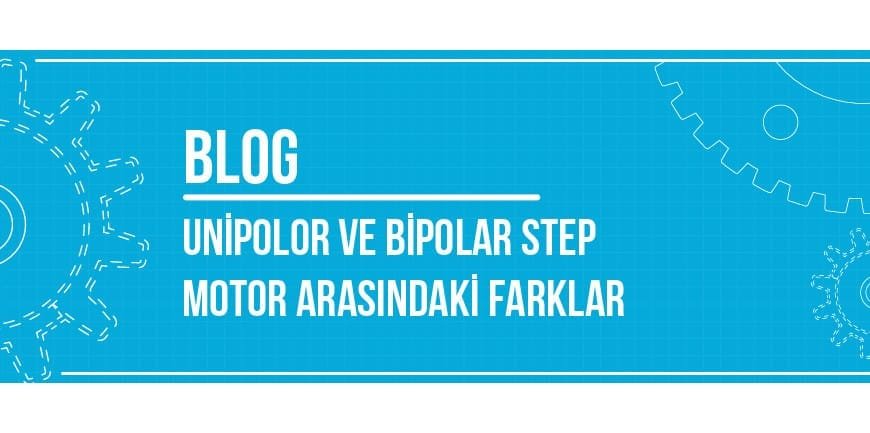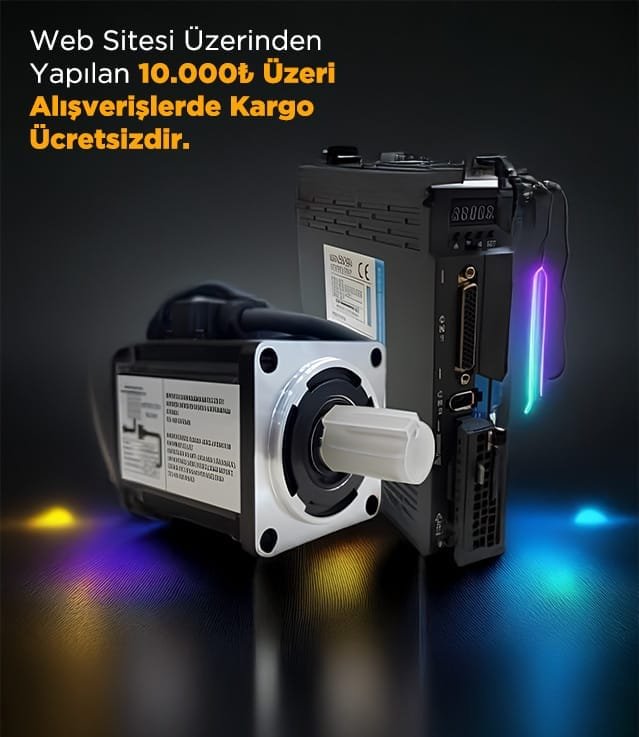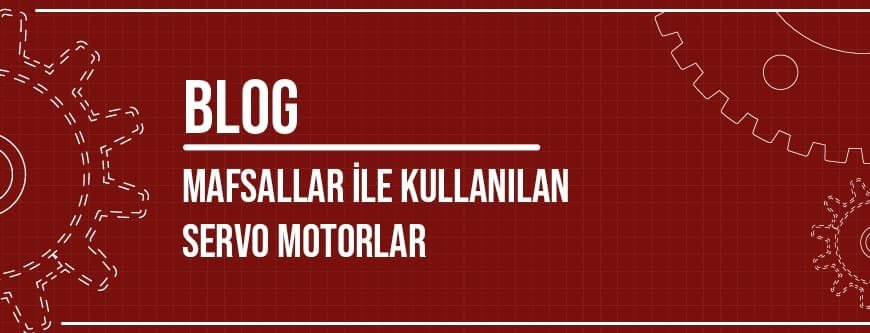
İçindekiler
Servo Motors Used with Joints
Servo motors used with joints are frequently preferred in industrial automation, robotic systems and applications requiring precise motion control. Because While servo motors enable machines and systems to operate with accurate positioning by providing high precision, speed and torque control, joints transmit the power and motion generated by these motors in different axes and angles, giving flexibility and freedom of movement to systems. For detailed information about these highly adaptable structures, you can take a look at our content.
What is a Joint and What Does It Do?
A joint is a mechanical fastener that connects two parts or components together to form a movable joint. This fastener is often used to provide rotational, angular or linear motion and keeps the direction or width of motion under control by limiting it. In this context, joints provide flexible and controlled movement of the connected components, while at the same time fulfilling a load-bearing function. For this reason, it has a wide range of applications from the automotive industry to construction, from robotic systems to biomechanical devices. This fastener also has important functions such as absorbing vibrations, providing impact resistance and preventing overloading of components during movement. As such, joints play a critical role in mechanical systems that require durability and reliability. Especially in vehicle suspension systems, spherical joints allow wheels to move in various directions, while fixed joints increase structural strength by holding different components of buildings together. Furthermore, in the field of biomechanics, joints can fulfill functions similar to human joints and support mobility in medical devices and prostheses.
What are the Types of Joints?
- Ball Joint
Spherical joints, one of the joint types, are a type of joint that has a ball and socket structure and provides multi-directional movement. These joints allow a ball-shaped component to rotate freely in a round socket. This gives the joint both rotational and angular movement. In addition, these joints are often preferred in automotive suspension systems, steering linkages and robotic arms, allowing the wheels to move in various directions, increasing driving comfort. In robotic systems, ball joints give the arm movements a wide range of motion, making it possible to perform complex tasks.
- Rotary Joint
Rotary joints, another type of joint, have a hinge-like structure that can only rotate around an axis. These joints provide a controlled and limited movement around a specific axis and at the same time, thanks to their simple and durable structure, they offer excellent performance in applications requiring angular movement. For this reason, it is widely used in door hinges, seat connections and opening-closing mechanisms.
- Sliding Joint
A slip joint is a type of joint used to provide linear motion. This joint allows components to make linear movements such as back and forth or up and down. For this reason, it is widely used in drawer slides, telescopic extension systems, rail doors and some industrial machines. In this context, Sliding joints provide a smooth transition by allowing components to move in a specific direction. They also help to realize linear motion smoothly by ensuring that moving parts slide in an orderly and stable manner.
- Fixed Joint
A fixed joint is a joint that does not provide movement but serves a supporting function by fixing two components together. Such joints provide stability by holding structural components together in a fixed manner. Due to these properties, they are mostly used in civil and structural engineering, for fixing buildings, bridges and other structural elements.
- Universal Joint (Cardan Joint or Hooke Joint)
The universal joint, which is the most commonly used joint type, connects components rotating at different angles by providing free movement around two axes. This type of joint usually allows the transfer of rotational motion at the points where two parts are connected to each other. For this reason, it is widely used in drive shaft connections in vehicles, shaft systems and various machines. Thus, it is frequently preferred in drive and power transmission systems.
- Flexible Joint
A flexible joint is a type of joint that absorbs vibrations and impacts that may occur during movement by allowing slight bending. This type of joint prevents strain on the fittings and ensures even distribution of loads in the system. At the same time, thanks to its flexible structure, it offers a flexible connection between moving parts and prevents excessive strain on the components during movement. For this reason, it is widely used in piping systems, some electrical connections and vibrating machines.
- Spring Joint
The last type of joint, spring joints, is a type of joint that has a spring inside and thus provides both rotational and linear motion. Since this type of joint contains a spring, it is resistant to shocks and impacts. Therefore, thanks to its shock absorption feature, it prevents overloading of moving parts and increases durability. At the same time, it prevents overloading of moving parts and increases durability thanks to its shock absorption feature.
What is the Working Principle of Joints?
The working principle of joints is based on providing controlled and directed movement between two components. However, this working principle may vary depending on the type of joint. In this context, the working principle of joints can be rotary, angular or linear. For example, a ball joint offers multi-directional movement, while a rotary joint only allows rotation around an axis. Sliding joints, on the other hand, provide movement in a linear direction.
In general, however, joints form a joint by allowing the components to which they are connected to move, and this joint allows movement to take place freely or within certain limits. In this context, joints are selected according to their load-bearing capacity and also fulfill functions such as absorbing vibrations during movement, impact resistance and preventing overload. Different types of joints are thus designed to meet specific types of movement and load requirements.
Areas of Use of Joints
Joints have different areas of use. Therefore, they have different features and working principles. Therefore, if we need to take a look at these usage areas, they are as follows;
1. Automotive Sector
- Suspension Systems: In vehicle suspension systems, ball joints allow the wheels to move as they change direction, thus greatly increasing ride comfort.
- Steering Joints: Joints, which are also used in vehicle steering systems, support maneuverability by providing moving connections. In this way, it increases driving control.
- Drive Shaft Connections: Universal joints used in drive shaft connections allow power transmission by adapting to angular differences in drive shaft systems.
2. Civil and Structural Engineering
- Bridge and Building Structures: Fixed joints are used in the connections of structural elements to increase durability and support the static load carrying capacity of buildings. In this way, it contributes to making structures more resistant to earthquakes, wind and other external influences.
- Earthquake Resistant Structures: Flexible joints provide movable connections during an earthquake, absorbing vibrations and increasing the durability of the structure.
3. Robotics and Automation Systems
- Robotic Arms: Spherical and rotary joints are used in the movable joints of robotic arms, allowing complex movements to be realized.
- CNC Machines: Sliding and rotary joints used in CNC machines are used for linear and angular movements in CNC machines that require precise position control. In this case, these joints enable CNC machines to perform complex machining tasks with high precision.
- Industrial Automation: Used for the harmonious and reliable operation of moving parts in factories, joints provide flexible and controlled connections between different components of machines, helping parts to work in harmony.
4. Medical Devices and Biomechanical Applications
- Prosthetics and Orthotics: Flexible and spring-loaded joints support users’ natural mobility by mimicking joint movements in biomechanical devices.
- Surgical Robots: Spherical joints are used to enable surgical robots to move with precision. This allows complex and delicate operations to be performed with high accuracy.
- Orthopedic Devices: Joints play a critical role in prosthetics and orthotics to provide motion support and improve joint function.
5. Mechanical Engineering and Industrial Equipment
- Telescopic Mechanisms: Sliding joints are used to provide linear motion in telescopic systems.
- Construction Machinery and Jacks: Fixed and ball joints are used in construction machinery to connect moving parts and transmit motion.
- Vibrating Equipment: Flexible joints protect machine components by absorbing shock and impact in vibrating machinery.
6. Aerospace Industry
- Aircraft Wings and Control Surfaces: Spherical and rotary joints provide movement on the control surfaces of airplanes, making it possible to change direction.
- Satellite Mechanisms: Joints help provide angular movement and flexibility in spacecraft. This enables components of spacecraft, especially satellites and robotic arms, to move at different angles and fulfill their missions.
- Landing Gear: Swivel and flexible joints help the landing gear to function properly by providing movable connections during landing.
7. Energy and Petroleum Industry
- Pipelines: In piping systems using flexible joints, the joints adapt to expansion and contraction due to temperature changes.
- Oil Refineries and Wells: Universal joints accommodate angular variations in pipe and shaft connections in oil wells.
- Solar Panels and Wind Turbines: Joints are used for orientation of solar panels and angular adjustment of the blades of wind turbines. Thus, solar panels can be oriented at the most efficient angle during the day, maximizing the collection of sunlight and increasing energy production.
8. Maritime and Shipbuilding
- Ship Propellers and Shafts: Universal joints are used in shaft connections of ship propellers to transfer motion and power.
- Deck Equipment: Rotary and ball joints form movable connections in deck equipment.
- Vibration Control: Flexible joints absorb vibrations on ships, increasing comfort and durability.
Things to Consider When Choosing a Joint
There are many points to consider when choosing a joint. These points allow the application to run at high efficiency. These points are as follows;
- Determine the need for rotational, angular or linear movement according to the type of application in which the joint will be used.
- Evaluate the amount of load the joint will carry and whether this load is static or dynamic. In this way, you can ensure safe operation of the system by selecting a joint suitable for the load capacity.
- Consider the type of movement (rotational, linear or multi-directional) and speed required by the application. For this, durable and smooth-running joints should be preferred for high-speed applications
- You should definitely consider the temperature, humidity, dust and chemical resistance requirements of the environment in which the joint will be used.
- The durability and suitability of the material from which the joint is manufactured is important for long-lasting performance. You should therefore choose from materials such as stainless steel, aluminum or high-strength alloys.
- You should definitely evaluate the assembly and maintenance processes of the joint. At this point, for an application that requires frequent maintenance, easily accessible and quick-maintenance joints should be selected.
- The degree of flexibility and movement tolerance of the joint must be suitable for the performance of the system. Otherwise, excessive flexibility or insufficient movement tolerance may adversely affect the operation of the system.
- Wear-resistant joints provide long life and low maintenance costs. For this reason, joints with high wear resistance should be preferred in applications requiring high durability.
Maintenance Requirements of Joints
The maintenance requirements for joints are essential to ensure their long life and reliable operation. For this reason, regular maintenance prevents wear of the joints, maintains their performance and prevents sudden breakdowns. At this point, the joint should first be cleaned and dust and dirt accumulations should be removed. You can also reduce friction and prevent wear by regularly lubricating the moving parts to ensure proper functioning. In this context, protective lubricants against corrosion and rust can be preferred according to the area of use of the joint.
Importance of Couplings and Gears on Joints
Couplings and gears play a critical role in the efficient operation of joints because these components provide excellent performance in the reliable transmission of power and motion. Here, Couplings provide a flexible or rigid connection between two rotating components, transmitting motion and torque, while maintaining the accuracy of movement of the joints and absorbing stresses caused by sudden shocks. Gears, on the other hand, change the speed and direction of movement, ensuring that the system to which the joints are connected operates at the desired performance level. For this reason, the harmony between couplings and gears is extremely important for the joints to work correctly. The main reason for this can be considered as reducing vibrations in the system and preventing wear of components.
In which cases are couplings and gears used in joints?
Couplings and gears are often used in mechanical systems where joints are used to efficiently transfer power and optimize motion control. For this reason, couplings are preferred to compensate for small misalignment errors between two rotating shafts, improve torque transmission and reduce vibrations, while flexible couplings help to smoothly transmit motion in shaft and joint systems operating on different axes.
Gears are used in situations where torque needs to be increased or decreased, direction of movement needs to be changed and speed needs to be controlled. In this case, couplings and gears are preferred to optimize motion and power transmission at joints.
How to Mount Couplings and Gears to Joints?
The assembly of couplings and gears to joints is a process that must be done carefully to ensure correct power transmission and motion control in mechanical systems. For this reason, during coupling assembly, the shaft of the servo motor and the input shaft of the joint must be perfectly aligned. Otherwise, unstable movement and wear may occur. After the input shaft is fully aligned, depending on the type of coupling used, the couplings must be fixed and tightly connected with flanges or clamping screws. In the case of gears, the gear wheels must be fully fitted to each other and the necessary lubrication must be applied. After all these operations have been carried out, the operation of the joint is checked and the correctness of the assembly is determined.
Servo Motor and Joint Compatibility for Motion Control
The compatibility of servo motors and joints for motion control is especially important in industrial automation and robotic systems in terms of precision and efficiency. This is because the tasks performed in these systems often require high precision and repeatability. Servo motors can control position, speed and torque with extreme precision, while joints convert this precision into mechanical movements at different angles and axes. However, if there is a mismatch or misalignment between the servo motor and the joint, the power generated by the motor cannot be fully transmitted. This leads to losses in motion control and reduced system performance. Therefore, servo motor and joint alignment is important for motion control.
How to Mount Joints on Servo Motors?
The mounting of joints to servo motors must be done carefully to ensure correct connection and motion control. Otherwise, a series of problems may arise in the system as a result of incorrect assembly. Therefore, the assembly process must be completed meticulously to avoid technical problems. In this case, the output shaft of the servo motor and the joint must be properly aligned. Then, the shaft diameter of the servo motor and the input size of the joint must be harmonized and, if necessary, a suitable transition must be ensured by using shaft adapters or fasteners at the connection points. In this way, the joints are fixed by means of a shaft, flange or locking system, ensuring a secure assembly process.
Advantages of Joints in Servo Motor Precision and Positioning
There are many advantages of joints in servo motor precision and positioning. If we take a look at these advantages in general;
1. Multi-axis Motion Capability
The joints allow servo motors to move in various angles and axes. In systems such as industrial robotic arms or CNC machines, this enables versatile and precise positioning with ease. At the same time, the joints enable precise motion control of the servomotors in each axis, while allowing motion to pass smoothly between these axes.
2. Flexibility in Precision Positioning
On the other hand, joints increase the flexibility of the precise positioning provided by servomotors. The main reason for this is that they allow large angular movements and precise positioning between moving parts. This provides a significant advantage in applications where workpieces need to be machined at different angles, especially in robotic automation processes.
3. Energy Efficiency and Motion Compensation
Providing energy efficiency and motion compensation, Joints mechanically compensate the motion provided by servo motors and prevent motor overload. Thus, servo motors can perform precise movements with less power consumption thanks to the joints. In addition, the smooth transmission of movements by the joints minimizes energy loss and increases the overall efficiency of the system.
4. Vibration Reduction and Stability
Joints with high levels of vibration reduction and stability increase the stability of the system by absorbing vibrations that may occur during the movement of servo motors. Thanks to this vibration reduction effect, it allows servo motors to make more precise movements and minimizes positioning errors.
5. Improvement in Load Distribution
In general, joints reduce mechanical stresses by evenly distributing the load and forces generated by servomotors. In this way, the load effect on the servo motor’s mobility is reduced and the system becomes more durable.
6. Wide Range of Motion
Servo motors can operate in wider ranges of motion thanks to joints. Especially in multi-axis systems such as industrial robotic arms and assembly lines, joints extend the range of motion of the servo motor, making it possible to operate on larger surfaces. This allows the precision offered by servo motors to be fully utilized in applications that require high precision.
7. Modular and Flexible Design Opportunities
When used together, joints and servo motors make it possible to design more modular and flexible systems. This is mainly because they can be easily reconfigured and quickly adapted to different production processes. In this context, both systems increase both functionality and precision.
The Role of Joints and Servo Motors in Industrial Applications
Joints and servo motors, which are frequently used in industrial applications, have an important place in the motion control of machinery and robotic systems. A joint is a connecting element that allows machines or robotic arms to move freely in different axes, while servo motors are a tool used to precisely control these movements. These two systems work together in industrial environments to manage machining, assembly or production processes that require high precision and control. Moreover, in CNC machines or robotic automation systems, the flexibility provided by joints and the precision offered by servo motors ensure that production processes run efficiently and without errors. The combination thus optimizes operational time and workforce while increasing quality in industrial production.
Joint and Servo Motor Usage in CNC Machines
The use of joints and servo motors in CNC machines is critical to ensure precise and efficient motion control. At this point, joints ensure that the moving parts of CNC machines are connected to each other and the angular movements between these parts are realized in a controlled manner. In this way, the machine can process at different angles and positions.
At the same time, servo motors are widely used in CNC machines for precise control of movement. In this case, the motors can control parameters such as position, speed and torque with extreme precision. At the same time, thanks to the feedback mechanism, servo motors continuously monitor the movement of the machine and make adjustments to ensure the desired movement. This enables complex and precise machining operations.
As a result, the use of knuckles and servo motors in CNC machines makes it possible to machine complex workpieces, increasing both speed and quality in the production process.
You can choose the most suitable servo motor by contacting the expert team of Şahin Rulman for the most suitable servo motors for joints.
FAQ
What are the challenges in integrating joints into servo motors?
The main challenges when integrating joints into servo motors include alignment errors, improper coupling selection, and incorrect assembly. However, these challenges can be avoided with the right assembly steps.
How do joints optimize the motion control of a servo motor?
Joints optimize motion control by transmitting the motion produced by the servo motor at different angles and axes. In this context, the movements that the servo motor performs with high precision are given wider and more flexible movement capability through the joints.
How do we ensure long life of servo motors and joints?
For servo motors and joints to have a long life, regular maintenance and lubrication, the system should not be subjected to overload and correct installation techniques should be applied.
What is a joint and how is it related to servo motors?
A joint is a mechanical element that joins two components and provides a moving connection. When servo motors are combined with joints, they are used to transmit and direct the motion produced by the motor. In this way, linear, rotational or angular motion is achieved.
Which joint types are used in servomotors?
Various types of joints are compatible with servo motors, such as ball joints (for multi-directional motion), rotary joints (for angular motion) and sliding joints (for linear motion).
How to maintain servo motor and joint system?
Connections and bearings should be checked regularly. The motor should be calibrated, temperature monitored and joints lubricated to prevent wear.
Why are servo motors and joint systems preferred in industry?
They are also widely used in automation and robotics systems because they offer precise motion and position control, high speed and flexibility. They also offer the advantage of high durability and long life.
How does the robotic arm structure work with servo motor and joint?
Servo motors provide motion to each joint of the robotic arm and this motion is transmitted along the joints by means of joints. Thus, the robotic arm can move in desired directions and angles.
Diğer Blog Yazılarımız



